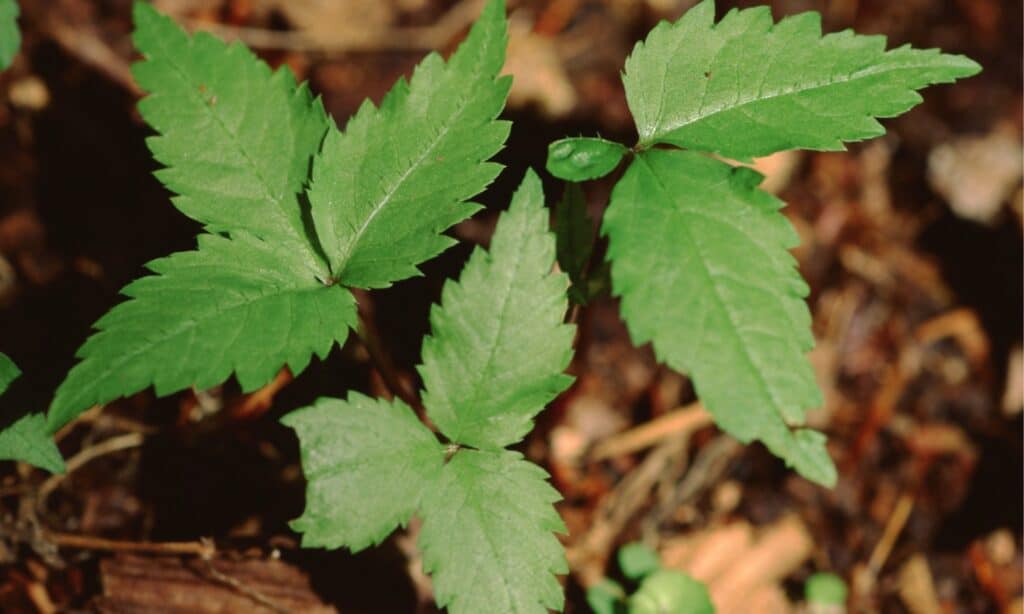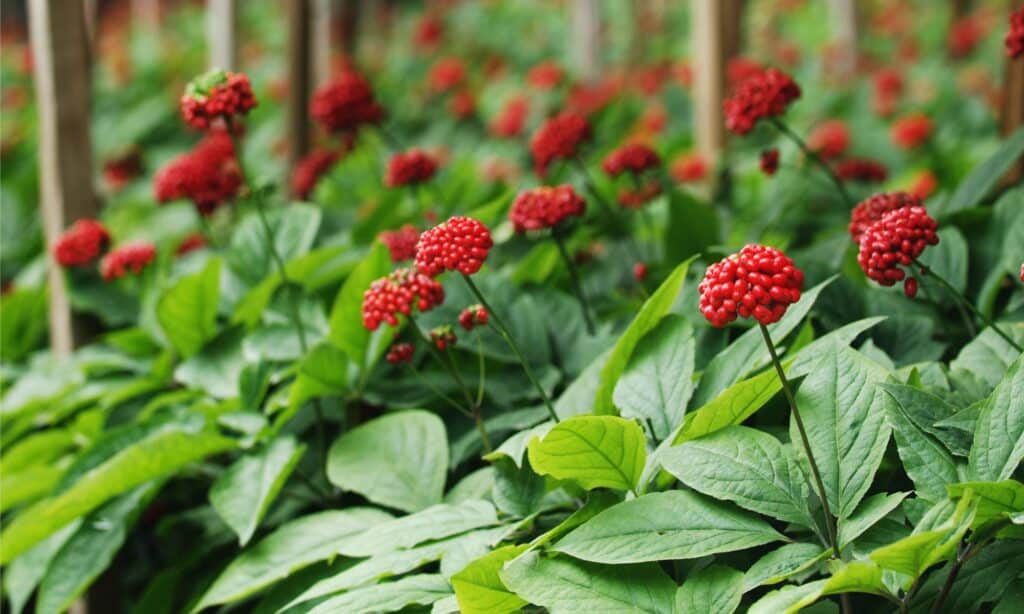Ginseng is best known as a supplement that may help you recover from a cold. It’s highly prized in Asian dishes and medicine, but did you know ginseng is a plant with several species in the ivy family and it’s primarily the root that’s harvested? Let’s see what the differences are between American ginseng vs. Panax ginseng.
What Are the Main Differences Between American Ginseng and Panax Ginseng?
American and Panax ginseng, which is also known as Korean or Asian ginseng, are very similar, but the main differences are their native location, height, and leaf margins.
What Is Ginseng?
Ginseng is a plant in the Panax genus that sits in the Araliaceae ivy family of 700 species. There are several recognized species of ginseng:
- Korean Ginseng (Panax ginseng)
- South China ginseng (Panax notoginseng)
- American ginseng (Panax quinquefolius)
The Panax genus is native to the United States, Canada, the Korean peninsula, northeast China and the Russian far east, but American ginseng and Panax ginseng are different species.
American Ginseng

iStock.com/Weber
American ginseng is native to eastern North America. It’s been exported to China since the 1700s where it’s prized for its cooling “yin” qualities in traditional Chinese medicine. Canada is the largest producer of American ginseng, but it’s found growing wild in shady, deciduous forests all over eastern North America. It’s not a protected species yet, but Maine and Rhode Island have declared it endangered due to over-harvesting.
Panax Ginseng
Panax ginseng is native to Asia where it’s prized for its hot “yang” qualities in traditional medicine. It also grows wild and is under government protection due to overharvesting.
Panax ginseng is also called Asian ginseng, Chinese ginseng, and Korean ginseng.

iStock.com/KirsanovV
The History of Ginseng
Ginseng appears in early Chinese written records and in the 1596 book the Compendium of Materia Medica as a tonic for those recovering from illness. Native Americans also used it as a medicine for headaches, stomach upsets and convalescing patients.
Over the years ginseng has become a valuable root. Korea and China have fought battles over ginseng fields, and since the 1700s ginseng has been traded from America to Asia.
Ginseng takes its name is taken from the Chinese characters for “person” and “plant root” and Panax is ancient Greek for “heals all.”
Is Ginseng Good for You?
Ginseng roots and leaves have been used in Native American and Chinese medicine for thousands of years, but there isn’t any proven research on its medical properties. Ginseng may improve memory, menopause symptoms, and insulin response, but there isn’t enough evidence to say for sure. Studies continue!
In Chinese medicine American ginseng represents the yin (cool) side and Panax ginseng represents the yang (hot). Ginseng is highly prized and big business in Asian countries.
How Do You Pronounce Ginseng?
It’s pronounced with j for jump rather than g for garden, so it’s “jin sing.”
American Ginseng vs. Panax Ginseng: Foliage
Ginsengs are perennial plants, which means they grow back each year, even if they lose all their foliage and stems. Both American and Panax ginseng have palmate leaves consisting of leaflets.
However, American ginseng is shorter. It grows to 18 inches tall with three distinct sets of large deep green leaves up to five inches across. They are hairless and have very finely serrated margins. Each compound leaf set grows on a single thin stem.
Panax ginseng is very similar but it will reach 24 inches so it’s the taller of the two ginsengs and has slightly paler green leaves. It has less obvious leaf sets and only rarely are they serrated. The main way to tell the difference is Panax ginseng’s lack of serration and more haphazard leaf sets.
American ginseng looks a little like poison ivy and it grows in the same locations. Be careful if you handle it. The best way to tell the difference is poison ivy has white berries and it’s deciduous (loses its foliage in winter).
Is There a Dwarf American Ginseng?
Dwarf American Ginseng exists and it is almost the same, except that it has three leaflets instead of five and only reaches 6 inches tall.
What Are Ginseng Root Differences?
American and Panax ginseng plants start life much like parsnips and as they grow they develop a forked root. The roots can reach several inches long and it’s the most prized part of the ginseng plant. In cultivation, a ginseng plant is considered mature after five years of growth. The older the plant, the bigger and better its roots.
Both species have roots that are creamy white beneath a gingery brown coating and though they are described as forked, each one is unique. They often resemble human forms, which is why there are folklore tales that say you must tie your ginseng down or it will run away!

iStock.com/Weber
American Ginseng vs. Panax Ginseng: Flowers
The flowers of American and Panax ginseng grow at the top of its stem’s tip where it branches out into foliage. One umbel of white flowers grows there containing up to 20 individual flowers that are 1/8 of an inch long.
The flowers have five petals and they bloom in late spring to early summer, sometimes into late summer. In fall, flowers mature into small red berries, but it doesn’t need a pollinating partner because ginseng reproduces with bisexual flowers.

iStock.com/odyphoto
How to Grow Ginseng
You can grow both types of ginseng, but they take a long time to mature, usually five to eight years before they are mature enough. This is why wild ginseng is overharvested, it just takes so long to ripen.
Here’s how to grow American ginseng:
- Plant seeds in the fall and keep them in the shade. In order to germinate ginseng the seeds need to be stratified, which means they need to experience low temperatures to shed the woody outer layer. You can buy already stratified seeds if you prefer.
- Choose a spot that’s preferably east or north-facing on a well-drained slope.
- Push seeds an inch deep into stone-free soil or compost and space them 15-20 inches apart because ginseng doesn’t like being moved.
- Now exercise patience because American takes up to 18 months to germinate!
- When the seedlings appear, keep them well watered. Ginseng likes a damp cool environment quite unlike most seedlings that need warmth.
- Add lots of thick organic mulch to replicate the understory of a forest
- Keep them protected from rabbits, deer, and other pests.
- Wait up to eight years for the harvest!
And Panax ginseng? Exactly the same method.
A quick word of warning. Ginseng is quite valuable and garden robberies have occurred. Some growers remove the leafy tops of their ginseng plant so no one knows what lies beneath!
Ginseng Growing Zones
Both American ginseng and Panax ginseng grow in zones 3 to 7.
Is Ginseng Toxic to Dogs?
The ASPCA doesn’t list ginseng as toxic to pets, but it’s always best to use a safe supplement recommended by your veterinarian if you want to introduce plants or herbs to a pet’s diet. Allowing unrestricted access to garden plants or adding herbs to their food bowls can result in an unintentional upset stomach.
Which Is Best American Ginseng or Panax Ginseng?
There is very little difference between these two varieties of ginseng. They originate in different continents where the wild versions are overharvested, and Panax ginseng grows taller than American ginseng. Panax ginseng has smoother leaf edges compared to the American species too.
The real difference lies in their herbal uses. While American ginseng holds the yin properties, Panax ginseng holds the yang. Some people think American ginseng has a milder taste, but others argue not, suggesting this is only because traditional medicine suggests it has cooler properties!
Up Next
- American Ginseng vs Korean Ginseng: 5 Key Differences
- Woolly Thyme vs Creeping Thyme
- Poison Ivy vs. English Ivy
The post American Ginseng vs. Panax Ginseng appeared first on AZ Animals.
from Animal News, Facts, Rankings, and More! - AZ Animals https://ift.tt/FcZ80MS